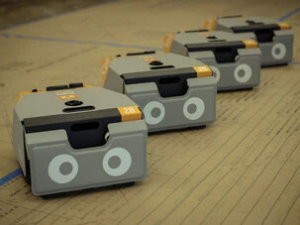Power conversion breakthroughs fuel a robot revolution

Innovations in power conversion technology are enabling a transformation in robotics design. Today’s integrated power modules are addressing the demanding size, weight, power budgets and cost efficiencies required to move robots from factory, residential and commercial applications into a vast new landscape bounded only by the imagination.
OLogic, a Santa Clara, Calif., electronics consultancy, has more than 15 years of experience helping its clientele bring robotics designs to market in both large and small volumes by providing electrical, mechanical and industrial engineering support, as well as software and firmware engineering. This includes expertise in power electronics integration, which is a prime design consideration that determines the range, functionality and charge capacity of mobile robots. OLogic has designed scores of robots across many industries including, agriculture, smart homes and inventory control to name a few.
Bringing power to the fore
Mobile robots have unique power challenges and require an array of power levels. Sensors, servo motors, actuators, data servers, communications systems and other devices that operate the robot have different power and power density requirements. Some are power-hungry. Others may operate infrequently. This demands the ability to provide power quickly, cleanly and cost-effectively from a battery-power source.
“The parts we’ve been using most lately are the Vicor ZVS Buck Regulators,” Larson said. “We use them everywhere on mobile robots now. I don’t ever have to think about, ‘Oh, I need five or ten amps at 12 volts, so I’m going to go build my own supply.’ I don’t ever think that way anymore.”
Saving time and money by automating building layout
One customer working closely with OLogic to optimize its power profile is Dusty Robotics (Dusty). Based in Mountain View, Calif., Dusty builds robot-powered tools for the modern construction workforce.
For centuries, the construction industry used two simple tools to lay out building floor plans: a tape measure and a chalk line. The tape measure and marker process are slow and prone to human error that impacts schedules and budgets. Errors cause rework, which typically account for ten percent of the cost of a construction project, according to Dusty.
“When plans are laid out by hand, a lot of mistakes are made, actually a lot more than the construction industry is even aware of,” said Philipp Herget, co-founder and CTO of Dusty Robotics. “We’ve heard of cases where layout mistakes have bankrupted construction companies. We prevent mistakes from happening because everything is marked correctly – not by hand, by a robot.”
Dusty FieldPrinter is 5x faster with zero mistakes
Dusty eliminates the conventional, labor-intensive process of physically transferring building plans onto the floor with a robot programmed at the job site to automate the same task. The Dusty FieldPrinter robot loads a digital version of the floorplan and then prints the layout on the ground for features such as walls, doors, plumbing and electrical chases. And it does so at speeds roughly five times faster than a human and to within one-sixteenth of an inch to spec.
Powering the Dusty FieldPrinter robot
Dusty’s FieldPrinter is a battery-powered mobile robot that operates for long periods in a variety of weather conditions. It includes many different electronic devices, including sensors, drive motors and motorized components, computationally-heavy processors and a printer – all of which have different operating voltage and current requirements. This is why Dusty engaged OLogic to build the core. After trying discrete power solutions electronics for its robot, OLogic soon discovered the time savings by changing to a modular approach to building power delivery networks (PDNs) for robots Additionally, Vicor modules, such as the ZVS Buck Regulator, are extremely cost-efficient given the 200 to 300 watts of power they deliver and their 97% efficiency.
With a long battery life and state-of-the-art power conversion technology, Dusty’s robotics innovation is helping digitize the construction industry by creating a single source of truth on the job site. Instead of the architect, general contractor and each trade partner working off of their own paper plans, everyone now builds off of the single design printed on the floor. The ability to provide a digital layout improves coordination between these myriad partners, enabling better planning, execution and faster completion.
Learn more about Ologic and Vicor
The original Press Release




